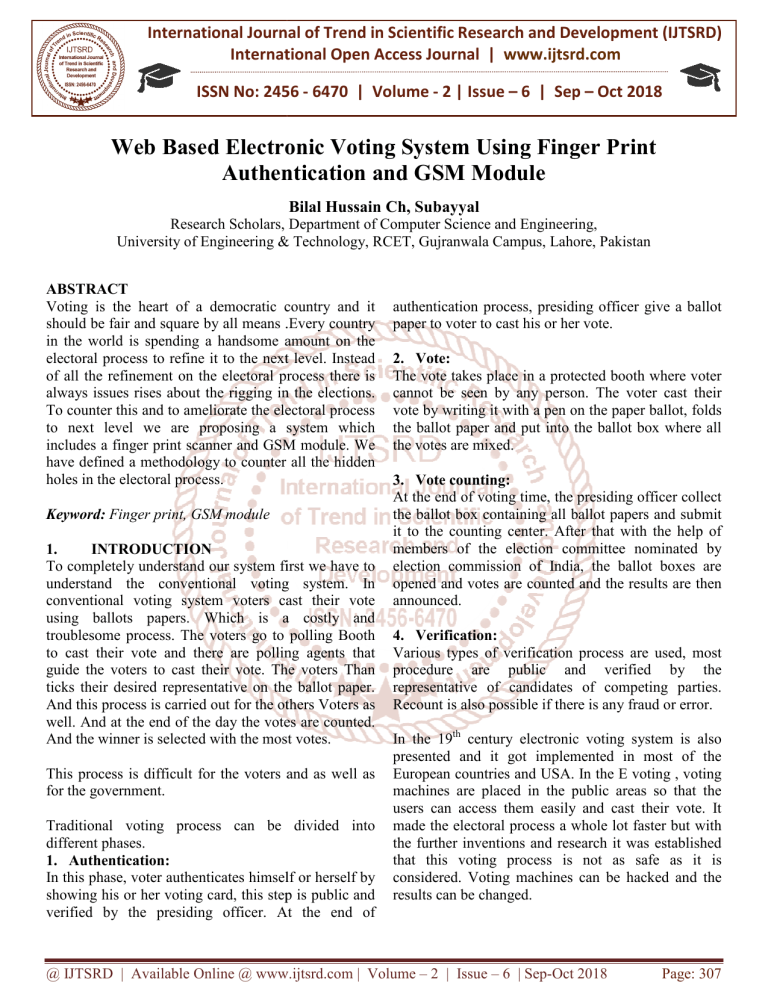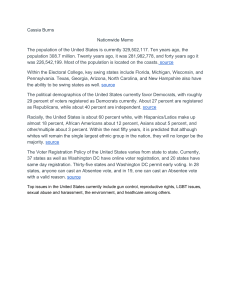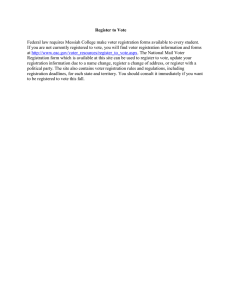
International Journal of Trend in Scientific Research and Development (IJTSRD)
International Open Access Journal | www.ijtsrd.com
ISSN No: 2456 - 6470 | Volume - 2 | Issue – 6 | Sep – Oct 2018
Web Based Electronic V
Voting
oting System Using Finger Print
Authentication and GSM Module
Bilal Hussain Ch, Subayyal
Research Scholars,, Department of Computer Science and Engineering,
Engineering
University of Engineering & Technology, RCET, Gujranwala Campus, Lahore,
Lahore Pakistan
ABSTRACT
Voting is the heart of a democratic country and it
should be fair and square by all means .Every country
in the world is spending a handsome amount on the
electoral process to refine it to the next level. Instead
of all the refinement on the electoral process there is
always issues rises about the rigging in the elections.
To counter this and to ameliorate
orate the electoral process
to next level we are proposing a system which
includes a finger print scanner and GSM module. We
have defined a methodology to counter all the hidden
holes in the electoral process.
Keyword: Finger print, GSM module
1.
INTRODUCTION
To completely understand our system first we have to
understand the conventional voting system. In
conventional voting system voters cast their vote
using ballots papers. Which is a costly and
troublesome process. The voters go to polling Booth
to cast their vote and there are polling agents that
guide the voters to cast their vote. The voters Than
ticks their desired representative on the ballot paper.
And this process is carried out for the others Voters as
well. And at the end of the day the votes are counted.
And the winner is selected with the most votes.
This process is difficult for the voters and as well as
for the government.
Traditional voting process can be divided into
different phases.
1. Authentication:
In this phase, voter authenticates
enticates himself or herself by
showing his or her voting card, this step is public and
verified by the presiding officer. At the end of
authentication process, presiding officer give a ballot
paper to voter to cast his or her vote.
2. Vote:
lace in a protected booth where voter
The vote takes place
cannot be seen by any person. The voter cast their
vote by writing it with a pen on the paper ballot, folds
the ballot paper and put into the ballot box where all
the votes are mixed.
3. Vote counting:
At the end of voting
ng time, the presiding officer collect
the ballot box containing all ballot papers and submit
it to the counting center. After that with the help of
members of the election committee nominated by
election commission of India, the ballot boxes are
opened and
d votes are counted and the results are then
announced.
4. Verification:
Various types of verification process are used, most
procedure are public and verified by the
representative of candidates of competing parties.
Recount is also possible if there is any fraud or error.
In the 19th century electronic voting system is also
presented and it got implemented in most of the
European countries and USA. In the E voting , voting
machines are placed in the public areas so that the
users can access them easily and cast their vote. It
made the electoral process a whole lot faster but with
the further inventions and research it was established
that this voting process is not as safe as it is
considered. Voting machines can be hacked and the
results can be changed.
@ IJTSRD | Available Online @ www.ijtsrd.com | Volume – 2 | Issue – 6 | Sep-Oct
Oct 2018
Page: 307
International Journal of Trend in Scientific Research and Development (IJTSRD) ISSN: 2456-6470
2456
To avoid all this confusion andd trouble we have
proposed a system that includes finger print scanning
and GSM module.
Casting phase:
In this phase the user will be given the privilege to
cast the vote. If all the steps before are satisfied
and completed then the user will be promoted to
this phase.
In this phase the user cast the vote .And at the end
the result will be calculated.
5. Benefits of our methodology:
The benefits of our methodology are:
Fairness:
Our system will introduce fairness in the electoral
process to next level. As the methodology
proposed by us is nearly impossible to break. So it
will introduce fairness in the electoral process.
In our methodology there are three phases:
Registration phase:: In this phase the voter will be
registered and all the information regarding the
voter is placed in thee database. In this phase the
voter will be prompted to input all his/her personal
information in the required field like his ID card
number, age , name, cell phone number. And after
that the user will be asked to place the finger on
the finger print devicee so that the image of the
finger is placed in the database. After all this,
registration phase will be completed.
Authentication phase:
This phase will start when the user is about to cast
the vote. When the user go the website to cast the
vote, before casting the vote this phase will begin.
The user is asked to place the finger on the device,
first the user is authenticated with the information
saved in the database at the time of registration. If
the user is authenticated the user will be given
permission to cast the vote.
Eligibility of voters:In our methodology we have made sure that only
authorized will be able to cast the vote.
Unauthorized voters will be caught at the start of
the process and will not be allowed to cast the
vote.
Uniqueness:We have defined uniqueness in our system. Every
voter has the unique identity because of the unique
finger print. No voter would be allowed to cast the
vote more than one time.
Privacy:We have paid special attention to privacy
p
in our
system. As the user will cast the vote over the
internet and can cast the vote anywhere.
So no one can access the information regarding
the vote of the voter. His/her privacy will be
maintained.
Accuracy:Our methodology is accurate. We have introduced
accurate and dependable devices in the system.
They will provide the most accurate result is all
conditions.
Efficiency:Efficiency is the important factor that we have
considered.
Our system will enhance the efficiency to the next
level.. Our methodology will provide the result in
minimal time and with precision.
@ IJTSRD | Available Online @ www.ijtsrd.com | Volume – 2 | Issue – 6 | Sep-Oct
Oct 2018
Page: 308
International Journal of Trend in Scientific Research and Development (IJTSRD) ISSN: 2456-6470
2456
Difference between other e-voting
voting systems and our
methodology:Due to intense need of the fairness in the electoral
process various modules have been proposed. Various
systems have been implemented in which finger print
authentication is using. But there is a main difference
between our methodology and other e voting scheme.
First of all our methodology includes GSM modules
that is absent in other types of systems. And besides
that we are using Finger print authentication modules,
functions of which are created in MATLAB and
advanced acquisition and comparison techniques are
used.
system and opens the website to register itself. The
user will be prompted to give the basic information
regarding himself / herself.
Remember our methodology is client/server based.
The voter will be the client. And its web based
architecture.
re. After the user will give all the
information about himself / herself then user will be
asked to provide the cell phone number and after that
the user is asked to place the finger on the device so
that the system can take the fair good impression of
the finger.
inger. We have used some MATLAB functions
and have created some of the functions regarding
image acquisition and image enhancement to get a
clear impression of the finger.
After all the working the voter will be registered and a
unique voter id will be generated
nerated in database for the
user. And thus the first phase will be completed this
way.
Authentication phase:In this phase the voter will be authenticated as it name
specifies.
We have used various built in functions and also
created some functions in MATLAB to enhance the
quality of the input image and to store it in the
database.
The use of the GSM module is that when the user
authorizes itself for the casting of the vote the
message is send to the given number of the voter and
the message contains the code for the vo
voting. The user
is asked to input the code in the required field in order
to cast the vote.
This phase will start right before the voting and the
last phase. In this phase,
ase, when the voter is ready to
cast the vote the voter will be prompted to place the
finger on the device so that the system can take a fair
good impression of the thumb. The image obtained
will be compared with the image placed in the
database for that voter.
oter. If the image matches with the
one in the database the user will be authorizes and
asked to cast the vote. And if the image doesn’t
matches with the one on the database the voter is not
authorized and will be not asked to cast the vote.
We have used some of the MATLAB functions and
also created some to remove the ambiguity of
matching the finger prints.
Explained view of the system:We are using two basic modules GSM and the Finger
print scanner. The use of both devices is immense and
vital.
Our proposed methodology is client/server based and
web based. The voter will cast the vote using Internet.
Our methodology consists of 3 phases:Registration phase:In this phase the voter will be registered. This is the
first phase in the system. The user will log
login in to the
@ IJTSRD | Available Online @ www.ijtsrd.com | Volume – 2 | Issue – 6 | Sep-Oct
Oct 2018
Page: 309
International Journal of Trend in Scientific Research and Development (IJTSRD) ISSN: 2456-6470
2456
Casting phase:After all the registration and authentication the voter
will be finally prompted to cast the vote.
Future work:In future the voting process can be more verified and
enhanced using
g our methodology.
The list of candidates will be visible to the voter and
the voter can tick the right one he/she wants.
We can attach other modules as well to enhance the
efficiency of the system. We can attach iris detection
and face detection to maximize the efficiency.
After the casting it is very easy and feasible to count
the votes. The votes would automatically be counted
at the end because of the efficiency of the system.
And the winner will be announced.
We can also attach speech recognition module.
Flowchart:-
Conclusion:We have defined the methodology using two modules
Finger print scanner and the GSM module. Both the
modules have vital importance in the system. Our
methodology is that we are using a client/ server
based architecture. In which the voter is a client. It’s a
web based architecture. First the user is registered
with his/her unique finger print in the database of the
government. After the registration phase there comes
the authentication phase and in the end tthere is casting
phase. In the authentication phase finger print of the
voter is compared with the finger print saved in the
database at the time of registration. . The use of the
GSM module is that when the user is about to cast the
vote a code is send to the cell phone of the voter. The
user will be asked to place the code in the field given
to cast the vote. Our methodology is unique, fair,
adaptable, secure and efficient.
References:1. R. Mercuri, “Electronic Vote Tabulation Checks
and Balances”, PhD thesis, University of
Pennsylvania, Philadelphia, PA, October 2000.
2. D. Rubin, “Security considerations for remote
electronic voting. Communications of the ACM,
45(12):39–44”,
44”,
December
2002.
http://avirubin.com/e-voting.security.html
voting.security.html
3. T. E. Carroll, D. Grosu, "A Secure and Efficient
Voter-controlled
controlled Anonymous Election Scheme,"
International
Conference
on
Information
Technology: Coding and computing, as Vegas,
pp.721 - 726, 2005.
4. C. H. Chen, C. M. Lan, and G. Homg, "A
Practical Voting Systems for Small Scale
Election," 3rd International Conference on
@ IJTSRD | Available Online @ www.ijtsrd.com | Volume – 2 | Issue – 6 | Sep-Oct
Oct 2018
Page: 310
International Journal of Trend in Scientific Research and Development (IJTSRD) ISSN: 2456-6470
2456
Information Technology: Research and Education,
Hsinchu, pp.322 - 326, 2005.
5. Z. Claudia, R. H. Francisco, and O. A. Daniel,
"SELES: An e-Voting System for Medium Scale
Online Elections," Process of the Sixth Mexican
International Conference on Computer Science,
Puebla, pp.50-57, 2005.
6. Maltoni D, Maio D, Jain A K, Prabhakar S,
Handbook of Fingerprint Recognition, 2nd ed.,
Springer, 2009
7. Altun A A, Kocer H E, Allahverdi, “Genetic
algorithm based feature selection level fusion
using fingerprint and iris biometrics”, Int. J.
Pattern Recog. Artif. Intell. (IJPRAI), 22(3): 585585
600, November 2008.
@ IJTSRD | Available Online @ www.ijtsrd.com | Volume – 2 | Issue – 6 | Sep-Oct
Oct 2018
Page: 311





